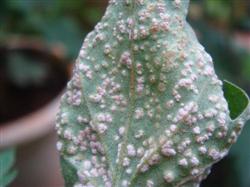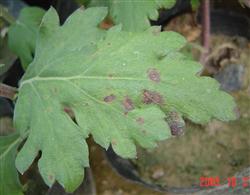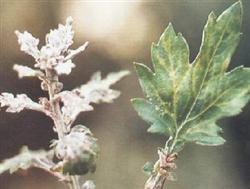Control technology of chrysanthemum white rust

Chrysanthemums are loved by people because of their beautiful, bright and fragrant flowers. Growing flowers can cultivate people's sentiment, enrich cultural life, and improve physical and mental health. At the same time, some varieties of chrysanthemums can be eaten or used in medicine, which can be said to kill two birds with one stone. However, in the process of cultivation and breeding of chrysanthemum, it is often attacked by a variety of diseases and insects, resulting in abnormal morphology, incomplete branches and leaves or withering, or even death of plants, thus reducing the ornamental value and medicinal value of flowers, resulting in greater economic losses. In order to ensure the normal growth and healthy development of chrysanthemum, to produce beautiful flowers, and to ensure the medicinal value of chrysanthemum, it is necessary to strengthen the prevention and control of diseases and insect pests. Prevention and control should be based on the principle of prevention and comprehensive treatment. That is, on the one hand, according to the habits, local climate and geographical conditions of the chrysanthemum, we should select suitable varieties and grasp the occurrence period of white rust in time, at the beginning of or before causing obvious harm to the disease. according to the harm characteristics and epidemic law of white rust, different prevention and control methods were adopted, and measures should be taken according to local conditions at that time. Take effective protective measures: on the other hand, prevent the spread of diseases as far as possible, comprehensive management is not a simple arrangement and make up of various control methods, we should coordinate various methods, learn from each other and cooperate with each other. in order to form a relatively complete and organically integrated prevention and control system. First, symptoms. First of all, there are very small discolored white spots on the back of the infected leaves, and then the bulge shows a gray-white pustule-like protuberance, the wax powder gradually becomes light brown, and the leaf front is a yellowish spot with slight depression, yellowish to yellowish green, and when the disease is serious, the whole leaf is covered with disease spots, resulting in the early death of the leaves. Second, the pathogen. The pathogen of white rust is that the teliospores of Spiraea chrysanthemum are piled on the back of the leaves, raised, grayish white to light yellowish brown, 2-5 microns in diameter, and the teliospores are oval (30-52) × (11-17) microns. Yellowish brown, bicellular, apical round or pointed, stalk colorless or yellowish. Third, the law of the disease: the pathogen overwintered with teliospores on the diseased and withered leaves of the diseased plants, and produced chlamydospores in the spring of the second year, which spread with the air flow and infected the leaves. The germination temperature of summer spores was 16-27 ℃, which was lower than 6 ℃ or higher than 31 ℃. The water film on the leaves is a necessary condition for spore germination. It is 10-25 ℃ in winter in Xishuangbanna, Yunnan, and there is almost no overwintering phenomenon of winter spores, that is, it is harmful to the germination of summer spores. In the cloudy days of open field cultivation, the weather of most Rain Water is serious, and the humidity in the greenhouse is too high, so it is easy to spread in time. Fourth, prevention and control methods 1, cultivate disease prevention, remove disease residues, choose fertile and deep soil, keep the upper part of the plant often dry, do not spray water from the upper part of the plant, strengthen the management in the greenhouse, and pay attention to ventilation. Transparent light to avoid close planting, control water and fertilizer, do not make the soil too moist. 2. Drug prevention and treatment. ⑴ transplanting seedlings to do a good job of soil disinfection or transplanting combined with fixed root water, irrigate 70% black tianqing 500 times liquid once. At the initial stage of ⑵, 15% triadimefon wettable powder can be sprayed with 1000 times liquid spray, 49% Jintian 9 # 600x liquid spray, or 20% triadimefon 200 times liquid spray control every 10 days, once every 10 days, due to continuous repeated use or high concentration of triadimefon, it will lead to shortening of chrysanthemum plant stems, abnormal thickening of leaves, smaller flowers and burning to death, so the above two drugs can be used alternately.
- Prev

Symptoms and pathogens of black spot of chrysanthemum
Chrysanthemum black spot, also known as brown spot, spot blight. The disease occurs in chrysanthemum cultivation areas. In addition to harming chrysanthemum, it can also damage many kinds of Compositae plants, such as wild chrysanthemum, chamomile, pyrethrum and so on. After the plant was damaged, the leaves of the light ones withered and fell off, and the serious ones died of the whole plant. Seriously affect the growth and ornamental of the plant. Symptoms.
- Next

Powdery mildew of chrysanthemum needs to be treated
From late August to October, chrysanthemum powdery mildew often occurs, which can lead to poor plant growth, leaf death, or even no flowering, which needs timely control. In cultivation, pay attention to cut off the dense and yellow branches and leaves, pull out the diseased plants, clean up the diseased leaves and fallen leaves, and burn them or bury them deeply. Planting should not be too dense, control soil moisture and increase.
Related
- Fuxing push coffee new agricultural production and marketing class: lack of small-scale processing plants
- Jujube rice field leisure farm deep ploughing Yilan for five years to create a space for organic food and play
- Nongyu Farm-A trial of organic papaya for brave women with advanced technology
- Four points for attention in the prevention and control of diseases and insect pests of edible fungi
- How to add nutrient solution to Edible Fungi
- Is there any good way to control edible fungus mites?
- Open Inoculation Technology of Edible Fungi
- Is there any clever way to use fertilizer for edible fungus in winter?
- What agents are used to kill the pathogens of edible fungi in the mushroom shed?
- Rapid drying of Edible Fungi

